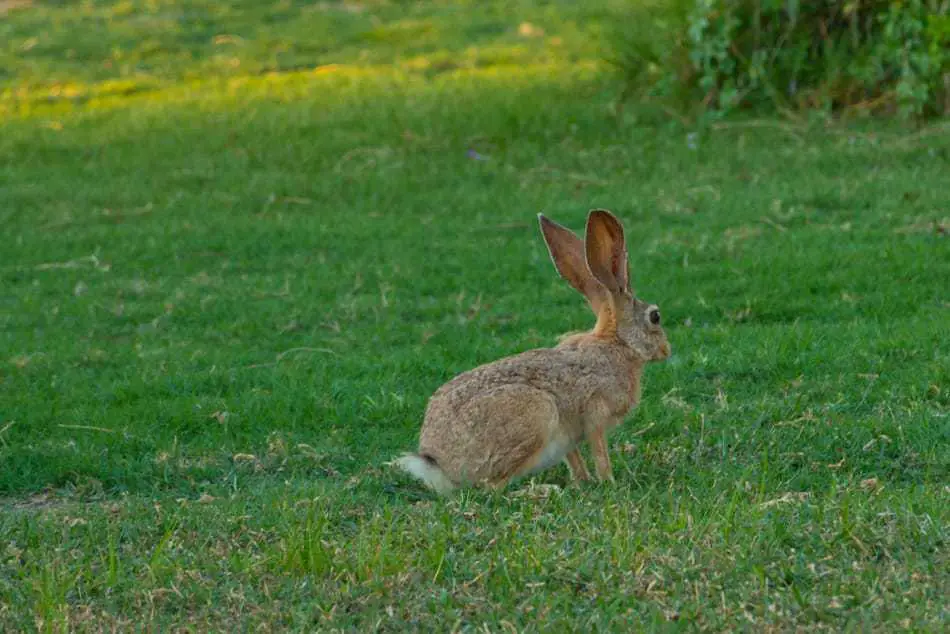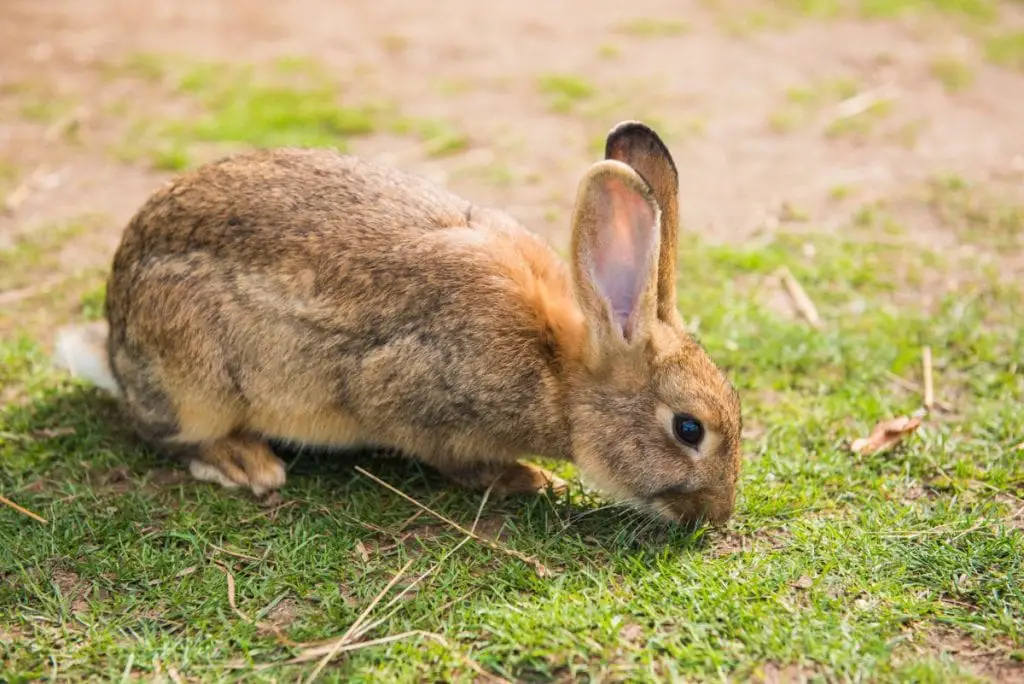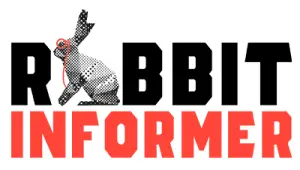
Have you seen wild rabbits romping through the grass in your area? I’m guessing you’ve not only seen them, but they’ve even won you over and now you’re willing to go out of your way to help them thrive by putting out some food. But you certainly don’t want to do harm by unknowingly putting out something that could be toxic to them. Believe it or not, there are many great food options lying around your kitchen right now, that are both healthy and delicious to those cute wild rabbits out your window!
As a general rule, the following types of foods are usually safe to feed to a wild rabbit.
- Dark leafy greens
- Some vegetables
- Fruit
- Herbs
- Edible flower petals
Although rabbits are resourceful foragers who find plenty of their required fiber and nutrients in their environment, below you’ll find a long list of foods that are acceptable to share with your neighborhood’s wild rabbit population, broken down by type.
Many food items you have right now in your fridge or garden will provide additional sustenance to your local rabbits’ daily diet! Let’s take a look at some of the do’s and don’t for feeding wild rabbits.
Fibrous Greens You Can Feed to Wild Rabbits
As part of their daily fiber requirement, wild rabbits will enjoy a number of different greens. Just like us, they get a boost of nutrients from those dark, leafy greens. Below are some examples of various greens you can feed to wild rabbits.
- Romaine lettuce
- Dark or green leaf lettuce
- Red leaf lettuce
- Collard greens
- Kale
- Watercress
- Spinach
- Carrot tops
- Mustard greens
- Beet greens
- Swiss chard
- Sprouts
- Radish tops
- Endive
- Turnip greens
Putting out a small, daily supply of greens, plus a special treat of a fruit or vegetable will make for happy wild rabbits and might even help you to connect with your local wildlife that much more!
Fruits and Vegetables You Can Feed to Wild Rabbits
The list below is a wide assortment of fruits and vegetables that would be great for a wild rabbit. Remember to keep the quantity you put out relatively small and to start introducing new items slowly.
If you’re feeding the wild rabbits store-bought produce, remember to rinse the items thoroughly, in order to remove any chemicals and pesticides. This is true for rabbits, just as much as humans!
Fruits
- Apple (without seeds)
- Banana (without peel)
- Raspberries
- Grapes
- Strawberries
- Pear
- Mango
- Papaya
- Melon (including peel and seeds)
- Plums
- Peaches
- Pineapple (outer skin removed)
- Blueberries
- Blackberries (with plant stem and leaves)
- Cherries (pitted)
- Kiwi
- Star fruit
- Apricot
- Currants
- Nectarine
Vegetables
- Celery (leaf and stalk)
- Cucumber
- Squash
- Zucchini
- Asparagus
- Broccoli (leaves and stem)
- Bok Choy (leaves)
- Pea pods (outside pod only)
- Carrots
- Brussel sprouts
Notes
Broccoli flowerets might cause digestive problems in rabbits, so it is best to offer only the leaves and stems.
Another notable warning is that only small amounts of carrots should be offered to wild rabbits. The greens of the carrot tops are the best portion of a carrot to offer.
Banana slices should be offered sparingly since they’re very high in sugar content, even though banana is a definite rabbit favorite.
Herbs You Can Feed to Wild Rabbits
Herbs are another option for rabbits in your area. You can plant specific herbs that are safe for wild rabbits and are herbs that you might want to use in your home as well. Below are some of the most common herbs that are also generally great to give to wild rabbits.
- Basil
- Cilantro
- Mint
- Dill
- Parsley
- Fennel
Flowers You Can Feed to Wild Rabbits
Edible flowers can be a special treat for wild rabbits and you can incorporate them into the landscaping of your yard if you want to attract wild rabbits. Remember though that they won’t be able to tell the difference between flowers you want them to eat, and decorative ones you don’t!
If you pay close attention to some of the plants growing in your area, you’re likely to find the native treats that the wild rabbits in your area are already enjoying. Here are a couple of edible flower varieties you might find in your own garden and which your rabbit friends will enjoy:
- Marigolds
- Roses
- Nasturtiums
- Pansies
- Hibiscus

Other Foods You Can Feed to Wild Rabbits
Here are a few other foods you can feed to wild rabbits in your area that don’t fit into the categories above.
- Sunflower Seeds – Many seeds are not good for wild rabbits to consume, but sunflower seeds aren’t one of them. They are a great treat and fully digestable for rabbits.
- Birdseed – Sometimes wild rabbits will find their fair share of birdseed spilled from bird feeders in the area. The good news is it isn’t harmful for them and if you have extra, you can try leaving it out down where they can get to it.
- Dried Fruits – Wild rabbits absolutely love dried fruit and it can be ok for them to have in small quantities, but it should be limited. They are extremely high in sugar.
- Hay – The same hay that you feed to pet rabbits can be used for wild rabbits in your area and it’s extremely good for them. I have great hay options you can easily purchase online listed in my new rabbit check list here.
- Rabbit Pellets – Your local feed or pet supply store should have rabbit food in pellet form. Although this isn’t something you’re likely to have laying around the house, it is a great option if you’re willing to buy something ideal for the rabbits in your area. Make sure you store rabbit pellets correctly so they don’t go bad. You can learn exactly how in my article on storing rabbit pellets the correct way.
While feeding the local rabbit population, you can experiment with covering the small container of food you leave out with some hand-cut grass to hopefully prevent the birds in the area from seeing the food and taking it before the local rabbits do.
Harmful Human Foods
Here’s a list of some human foods wild rabbits should not be given. Some can be generally harmful to their health while others can kill a rabbit, depending on how much they eat.
- Grains (bread, crackers, cereal and rice)
- Food high in carbohydrates
- High-sugar food (chips, candy, cookies, chocolate)
- Meat
- Eggs
- Milk and dairy products (including yogurt, butter, ice cream)
- Nuts and nut products
- Iceberg lettuce
- Cabbage
- Plants that are known as “nightshade plants” (potatoes, tomatoes, peppers, eggplant)
- Rhubarb
- Avocado
- Peas (the exterior pod is ok)
- Beans (legumes)
- Cauliflower
- Corn
- Leeks
- Chives
- Onions
- Cow’s milk
- Baby formula
- Cooked foods
The digestive system of rabbits is very different from our own. It’s important to avoid any foods that cause gaseousness or bloating because rabbits are unable to pass gas or vomit. Stomach discomfort and severe illness can be the results of feeding a rabbit incorrect foods.
When and Where to Feed Wild Rabbits in the Area
In terms of when you should feed them, wild rabbits are most active in the morning and evening. They generally sleep a good part of the day but are known as crepuscular animals, meaning that they are active when they feel least likely to be noticed, which is usually in the twilight hours of early morning and just before nightfall.
Wild rabbits enjoy eating in a wooded area or a place with heavy shrubbery, particularly towards the edges of open spaces that contain their main dietary staple of grasses. You might think of building your area’s wild rabbits a small brush collection along the edge of your yard’s lawn, for example.
Experts on Wild Rabbit Habitats Advise:
– Rabbits Life (source)
“The best way to feed a wild rabbit is to cut him grass. Use scissors, not a lawn mower. The cutting action of the mower crushes the grass, which causes it to begin to ferment.”
A small, sheltered patch would be ideal for your rabbits’ feeding ground. This might be adjacent to a patch of lawn you have left to grow long and where the rabbits will enjoy foraging for their daily fiber intake. If there’s shrubbery close by, the rabbits will also enjoy these plants as a natural food source and camouflage protection.
If you are going to use your yard as a rabbit feeding haven, make sure you’re not applying any pesticides or other chemicals to your lawn, grass, shrubbery, or garden foods you grow and harvest the rabbits in the area.
Attracting Predators and Pests
There are some realities involved in feeding wild rabbits that we can’t forget about, one of them is simply that rabbits are prey to many other animals and it’s only natural for a wild animal to follow their food source. So if you attract wild rabbits to your property, they might be attracting predators also.
Also, the food you leave out for the wild rabbits in your area might also attract other animals and pests as well. Some of the others animals (and bugs) who may be attracted to your property, as a result, are listed below.
Potential Predators and Unwanted Pests
- Raccoons
- Rats and mice
- Coyotes
- Foxes
- Mountain lions
- Bobcats
- Ants
- Skunks
- Squirrels
- Cats
Remember that the law of nature dictates that some wild animals are predators of rabbits and unintentionally attracting them may cause some frightening encounters for your rabbit friends. You might find that wild rabbits you have been regularly feeding aren’t coming around anymore.
Don’t take it personally if that happens, rabbits change their grazing locations based on the other animal species in the vicinity and their sense of danger.
Feeding Baby Wild Rabbits
If you come across baby rabbits whom you’re tempted to pick up, shelter or feed, it’s usually best to leave them alone and just observe their location. Although they might seem vulnerable, it’s likely that the mother rabbit has left them alone to avoid attracting attention to their hiding location.
She is likely to return to feed them in the cover of darkness. If the baby rabbits look plump and thick, then they’re likely well-fed and are being cared for by mom.
“A good rule of thumb is, if you have to chase a baby rabbit to catch him or her, the rabbit is fine!”
People for the Ethical Treatment of Animals – PETA (source)
Baby rabbits are milk-fed by their lactating mother and any rescue operation should involve your area’s wildlife experts, as infant rabbits need to be bottled-fed for the first month if the mother is no longer able to care for them.
Often, goat’s milk is used as a substitute for the mother’s natural milk and baby rabbits often need to be fed by syringe or eyedropper. In other words, observe the babies, and only if you suspect there’s a problem should you call your local animal control officer.
Are They Really Wild Rabbits?
Unfortunately, many people abandon domesticated rabbits and assume they will be able to survive in the wild. These rabbits may be attracted to human food sources and may need nutritional supplementation, as their own ability to forage for food has likely been hampered during their breeding and bunny stages.
- Wild Rabbits – North American wild rabbits are, for the most part, cottontail rabbits. Cottontails are most often brown rabbits with a whitetail and weigh 2 to 3 pounds.
- Pet rabbits – They’re noticeable for their color variations and other unique features. Their fur can be multi-colored or pure white or black. They can have random patterning on their coats which could include stripes or blotches of color. Their ears might be long and floppy or they might stand up straight. According to the Humane Society, the typical domesticated rabbit released to the wild is approximately 5 lbs in size.
If you want to learn more about the natural behaviors of pet rabbits once they escape, you can take a look at my article Do Pet Rabbits Come Back if They Escape. It’ll really help you to know what to look for to identify a possible pet rabbit living in nature because they were released or escaped.
Is It Safe to Feed Wild Rabbits?
For the rabbit’s sake and for yours, you should not handle a wild rabbit directly nor hand-feed them. Baby bunnies should be left in their nest and not disturbed.
Remember to wash your hands well before preparing your wild rabbit’s snack, just as you would consider proper food handling procedures for items prepared for human consumption.
You can feed wild rabbits without coming into direct contact with them by leaving their food treats in an open area. Certainly, you might want to use a bowl or pet food dish to place their food in, but you should leave these receptacles for the rabbits to find on their own.
You should not put your fingers near the rabbit’s mouth. Rabbits can carry the Francisella tularensis bacteria which causes Tularemia in humans. This is a serious disease that causes inflammation of your organs and can even be life-threatening. Wild rabbits are common carriers and direct handling should be avoided. If there is a situation where you believe directly handling a rabbit is necessary (such as getting a sick or injured rabbit to safety), call your local animal control officer.
What Do Rabbits Eat in the Wild?
Wild bunnies, like their domesticated relatives, are herbivores and they subsist on a high-fiber diet. A bunny’s digestive system is delicate and, in the wild, they’re excellent foragers. Rabbits are often seen nibbling away at grass as this staple provides the fiber their bodies need. Left to their own instincts, rabbits will focus on grass, shrubs, plants, and even twigs and bark.
Let’s take a quick look at the full range of a wild rabbit’s typical diet in its natural surroundings. Their diet changes considerably, given the season, so we’ll break things down a bit:
Warmer Seasons (Spring and Summer)
- Grass
- Weeds
- Wild clover
- Wildflowers
- Garden flowers
- Garden vegetable plants
- Shrubbery
- Tree seedlings
Colder Seasons (Fall and Winter)
- Twigs
- Buds
- Bark
- Conifer (pine) needles
- Any surviving green plants
Final Thoughts
Proceed slowly and get to know your new friends as you enjoy the process of understanding their habitat and behaviors. Introduce new foods slowly and in small amounts. Watch for any change in the rabbit droppings, as this can indicate that the rabbits’ diet has skewed towards an unhealthy imbalance.
Since we know that it’s best for wild animals to continue to live in their wild state, without becoming over-reliant on a human food provider who may not be able to continue sending nourishment their way. Instead, it would be wise to consider whether constructing a grass-rich feeding area in your yard might suffice, with very occasional treats left out for the bunnies you are quietly caring for.
Also remember that positive, daily interaction with nature is known to relieve stress and anxiety, and now more than ever, our mental health is important to maintain. Developing a close connection with the wild rabbit population in your area is a great way to relieve stress and if done right, help out those cute bunnies in the process.
